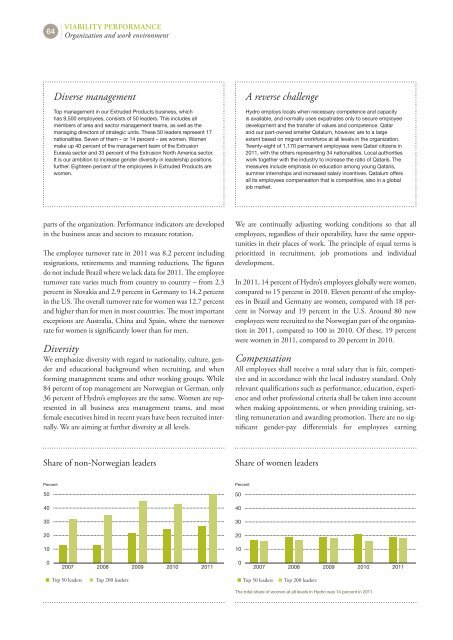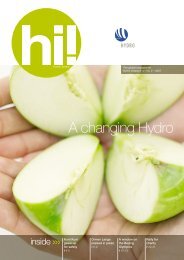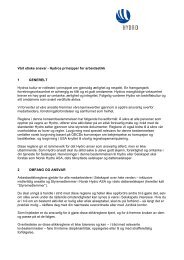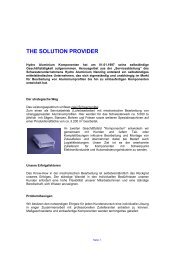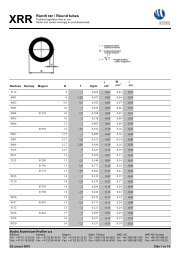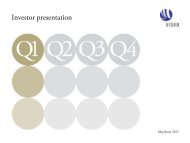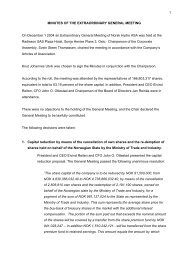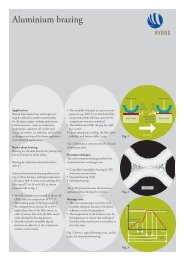Hydro Annual Report 2011b
Hydro Annual Report 2011b
Hydro Annual Report 2011b
You also want an ePaper? Increase the reach of your titles
YUMPU automatically turns print PDFs into web optimized ePapers that Google loves.
64<br />
Diverse management<br />
Top management in our Extruded Products business, which<br />
has 9,500 employees, consists of 50 leaders. This includes all<br />
members of area and sector management teams, as well as the<br />
managing directors of strategic units. These 50 leaders represent 17<br />
nationalities. Seven of them – or 14 percent – are women. Women<br />
make up 40 percent of the management team of the Extrusion<br />
Eurasia sector and 33 percent of the Extrusion North America sector.<br />
It is our ambition to increase gender diversity in leadership positions<br />
further. Eighteen percent of the employees in Extruded Products are<br />
women.<br />
parts of the organization. Performance indicators are developed<br />
in the business areas and sectors to measure rotation.<br />
The employee turnover rate in 2011 was 8.2 percent including<br />
resignations, retirements and manning reductions. The figures<br />
do not include Brazil where we lack data for 2011. The employee<br />
turnover rate varies much from country to country – from 2.3<br />
percent in Slovakia and 2.9 percent in Germany to 14.2 percent<br />
in the US. The overall turnover rate for women was 12.7 percent<br />
and higher than for men in most countries. The most important<br />
exceptions are Australia, China and Spain, where the turnover<br />
rate for women is significantly lower than for men.<br />
Diversity<br />
We emphasize diversity with regard to nationality, culture, gender<br />
and educational background when recruiting, and when<br />
forming management teams and other working groups. While<br />
84 percent of top management are Norwegian or German, only<br />
36 percent of <strong>Hydro</strong>’s employees are the same. Women are represented<br />
in all business area management teams, and most<br />
female executives hired in recent years have been recruited internally.<br />
We are aiming at further diversity at all levels.<br />
Share of non-Norwegian leaders<br />
Percent<br />
50<br />
40<br />
30<br />
20<br />
10<br />
0<br />
vIABIlItY perForMAnCe<br />
Organization and work environment<br />
2007<br />
Top 50 leaders<br />
2008<br />
Top 200 leaders<br />
2009<br />
2010<br />
2011<br />
A reverse challenge<br />
<strong>Hydro</strong> employs locals when necessary competence and capacity<br />
is available, and normally uses expatriates only to secure employee<br />
development and the transfer of values and competence. Qatar<br />
and our part-owned smelter Qatalum, however, are to a large<br />
extent based on migrant workforce at all levels in the organization.<br />
Twenty-eight of 1,170 permanent employees were Qatari citizens in<br />
2011, with the others representing 34 nationalities. Local authorities<br />
work together with the industry to increase the ratio of Qataris. The<br />
measures include emphasis on education among young Qataris,<br />
summer internships and increased salary incentives. Qatalum offers<br />
all its employees compensation that is competitive, also in a global<br />
job market.<br />
We are continually adjusting working conditions so that all<br />
employees, regardless of their operability, have the same opportunities<br />
in their places of work. The principle of equal terms is<br />
prioritized in recruitment, job promotions and individual<br />
development.<br />
In 2011, 14 percent of <strong>Hydro</strong>’s employees globally were women,<br />
compared to 15 percent in 2010. Eleven percent of the employees<br />
in Brazil and Germany are women, compared with 18 percent<br />
in Norway and 19 percent in the U.S. Around 80 new<br />
employees were recruited to the Norwegian part of the organization<br />
in 2011, compared to 100 in 2010. Of these, 19 percent<br />
were women in 2011, compared to 20 percent in 2010.<br />
Compensation<br />
All employees shall receive a total salary that is fair, competitive<br />
and in accordance with the local industry standard. Only<br />
relevant qualifications such as performance, education, experience<br />
and other professional criteria shall be taken into account<br />
when making appointments, or when providing training, settling<br />
remuneration and awarding promotion. There are no significant<br />
gender-pay differentials for employees earning<br />
Share of women leaders<br />
Percent<br />
50<br />
40<br />
30<br />
20<br />
10<br />
0<br />
2007<br />
Top 50 leaders<br />
2008<br />
Top 200 leaders<br />
2009<br />
2010<br />
The total share of women at all levels in <strong>Hydro</strong> was 14 percent in 2011.<br />
2011


